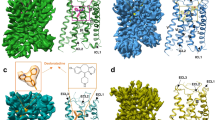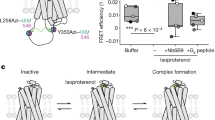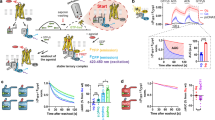Abstract
G protein–coupled receptors (GPCRs) constitute a large and functionally diverse family of transmembrane proteins. They are fundamental in the transfer of extracellular stimuli to intracellular signaling pathways and are among the most targeted proteins in drug discovery. The detailed molecular mechanism for agonist-induced activation of rhodopsin-like GPCRs has not yet been described. Using a combination of site-directed mutagenesis and molecular modeling, we characterized important steps in the activation of the human histamine H1 receptor. Both Ser3.36 and Asn7.45 are important links between histamine binding and previously proposed conformational changes in helices 6 and 7. Ser3.36 acts as a rotamer toggle switch that, upon agonist binding, initiates the activation of the receptor through Asn7.45. The proposed transduction involves specific residues that are conserved among rhodopsin-like GPCRs.
This is a preview of subscription content, access via your institution
Access options
Subscribe to this journal
Receive 12 print issues and online access
$259.00 per year
only $21.58 per issue
Buy this article
- Purchase on Springer Link
- Instant access to full article PDF
Prices may be subject to local taxes which are calculated during checkout




Similar content being viewed by others
References
Unger, V.M., Hargrave, P.A., Baldwin, J.M. & Schertler, G.F. Arrangement of rhodopsin transmembrane α-helices. Nature 38, 203–206 (1997).
Palczewski, K. et al. Crystal structure of rhodopsin: A G protein-coupled receptor. Science 289, 739–745 (2000).
Deupi, X. et al. Conformational plasticity of GPCR binding sites; structural basis for evolutionary diversity in ligand recognition. in The G Protein-Coupled Receptors Handbook (ed. Devi, L.A.) (Humana Press, Totowa, 2005).
Mirzadegan, T., Benko, G., Filipek, S. & Palczewski, K. Sequence analyses of G-protein-coupled receptors: similarities to rhodopsin. Biochemistry 42, 2759–2767 (2003).
Shi, L. & Javitch, J.A. The binding site of aminergic G protein-coupled receptors: the transmembrane segments and second extracellular loop. Annu. Rev. Pharmacol. Toxicol. 42, 437–467 (2002).
Ballesteros, J.A. & Weinstein, H. Integrated methods for the construction of three-dimensional models and computational probing of structure-function relations in G protein coupled receptors. Methods Neurosci. 25, 366–428 (1995).
Ohta, K. et al. Site-directed mutagenesis of the histamine H1 receptor: roles of aspartic acid107, asparagine198 and threonine194. Biochem. Biophys. Res. Commun. 203, 1096–1101 (1994).
Nonaka, H. et al. Unique binding pocket for KW-4679 in the histamine H1 receptor. Eur. J. Pharmacol. 345, 111–117 (1998).
Bruysters, M. et al. Mutational analysis of the histamine H1-receptor binding pocket of histaprodifens. Eur. J. Pharmacol. 487, 55–63 (2004).
Moguilevsky, N., Differding, E., Gillard, M. & Bollen, A. Rational drug design using mammalian cell lines expressing site-directed mutants of the human H1 histamine receptor. in Animal Cell Technology: Basic & Applied Aspects, Vol. 9 (eds. Nagai, K. & Wachi, M.) 65–69 (Kluwer Academic Publishers, Dordrecht, 1998).
Wieland, K. et al. Mutational analysis of the antagonist-binding site of the histamine H1 receptor. J. Biol. Chem. 274, 29994–30000 (1999).
Gillard, M., Van Der Perren, C., Moguilevsky, N., Massingham, R. & Chatelain, P. Binding characteristics of cetirizine and levocetirizine to human H1 histamine receptors: contribution of Lys191 and Thr194. Mol. Pharmacol. 61, 391–399 (2002).
Leurs, R., Smit, M.J., Meeder, R., Ter Laak, A.M. & Timmerman, H. Lysine200 located in the fifth transmembrane domain of the histamine H1 receptor interacts with histamine but not with all H1 agonists. Biochem. Biophys. Res. Commun. 214, 110–117 (1995).
Leurs, R., Smit, M.J., Tensen, C.P., Ter Laak, A.M. & Timmerman, H. Site-directed mutagenesis of the histamine H1-receptor reveals a selective interaction of asparagine207 with subclasses of H1-receptor agonsits. Biochem. Biophys. Res. Commun. 201, 295–301 (1994).
Moguilevsky, N. et al. Pharmacological and functional characterisation of the wild-type and site-directed mutants of the human H1 histamine receptor stably expressed in CHO cells. J. Recept. Signal Transduct. Res. 15, 91–102 (1995).
Visiers, I., Ballesteros, J.A. & Weinstein, H. Three-dimensional representations of G protein-coupled receptor structures and mechanisms. Methods Enzymol. 343, 329–371 (2002).
Shi, L. et al. β2 adrenergic receptor activation. Modulation of the proline kink in transmembrane 6 by a rotamer toggle switch. J. Biol. Chem. 277, 40989–40996 (2002).
Ruprecht, J.J., Mielke, T., Vogel, R., Villa, C. & Schertler, G.F.X. Electron crystallography reveals the structure of metarhodopsin I. EMBO J. 23, 3609–3620 (2004).
Ballesteros, J.A. et al. Activation of the β2-adrenergic receptor involves disruption of an ionic lock between the cytoplasmic ends of transmembrane segments 3 and 6. J. Biol. Chem. 276, 29171–29177 (2001).
Visiers, I. et al. Structural motifs as functional microdomains in G-protein-coupled receptors: energetic considerations in the mechanism of activation of the serotonin 5-HT2A receptor by disruption of the ionic lock of the arginine cage. Int. J. Quantum Chem. 88, 65–75 (2002).
Scheer, A., Fanelli, F., Costa, T., De Benedetti, P.G. & Cotecchia, S. The activation process of the α1B-adrenergic receptor: potential role of protonation and hydrophobicity of a highly conserved aspartate. Proc. Natl. Acad. Sci. USA 94, 808–813 (1997).
Oliveira, L., Paiva, A.C.M., Sander, C. & Vriend, G. A model for G protein interaction in G protein coupled receptors. Trends Pharmacol. Sci. 15, 170–172 (1994).
Ghanouni, P. et al. The effect of pH on β2 adrenoceptor function. Evidence for protonation-dependent activation. J. Biol. Chem. 275, 3121–3127 (2000).
Farrens, D.L., Altenbach, C., Yang, K., Hubbell, W.L. & Khorana, H.G. Requirement of rigid-body motion of transmembrane helices for light activation of rhodopsin. Science 274, 768–770 (1996).
Gether, U., Asmar, F., Meinild, A.K. & Rasmussen, S.G.F. Structural basis for activation of G-protein-coupled receptors. Pharmacol. Toxicol. 91, 304–312 (2002).
Meng, E.C. & Bourne, H.R. Receptor activation: what does the rhodopsin structure tell us? Trends Pharmacol. Sci. 22, 587–593 (2001).
Govaerts, C. et al. A conserved Asn in transmembrane helix 7 is an on/off switch in the activation of the thyrotropin receptor. J. Biol. Chem. 276, 22991–22999 (2001).
Urizar, E. et al. An activation switch in the rhodopsin family of G protein coupled receptors: the thyrotropin receptor. J. Biol. Chem. 280, 17135–17141 (2005).
Claeysen, S. et al. A conserved Asn in TM7 of the thyrotropin receptor is a common requirement for activation by both mutations and its natural agonist. FEBS Lett. 517, 195–200 (2002).
Hubbell, W.L., Altenbach, C., Hubbell, C.M. & Khorana, H.G. Rhodopsin structure, dynamics, and activation: a perspective from crystallography, site-directed spin labeling, sulfhydryl reactivity, and disulfide cross-linking. Adv. Protein Chem. 63, 243–290 (2003).
Almaula, N., Ebersole, B.J., Zhang, D., Weinstein, H. & Sealfon, S.C. Mapping the binding site pocket of the serotonin 5-hydroxytryptamine2A receptor. Ser3.36(159) provides a second interaction site for the protonated amine of serotonin but not of lysergic acid diethylamide or bufotenin. J. Biol. Chem. 271, 14672–14675 (1996).
Akabas, M.H., Stauffer, D.A., Xu, M. & Karlin, A. Acetylcholine receptor channel structure probed in cysteine-substitution mutants. Science 258, 307–310 (1992).
Bakker, R.A., Schoonus, S.B., Smit, M.J., Timmerman, H. & Leurs, R. Histamine H1-receptor activation of nuclear factor-κB: roles for Gβγ- and Gαq/11-subunits in constitutive and agonist-mediated signaling. Mol. Pharmacol. 60, 1133–1142 (2001).
Ballesteros, J.A., Deupi, X., Olivella, M., Haaksma, E.E.J. & Pardo, L. Serine and threonine residues bend α-helices in the χ1 = g− conformation. Biophys. J. 79, 2754–2760 (2000).
McAllister, S.D. et al. Structural mimicry in class A G protein-coupled receptor rotamer toggle switches: the importance of the F3.36(201)/W6.48(357) interaction in cannabinoid CB1 receptor activation. J. Biol. Chem. 279, 48024–48037 (2004).
Li, J., Edwards, P.C., Burghammer, M., Villa, C. & Schertler, G.F.X. Structure of bovine rhodopsin in a trigonal crystal form. J. Mol. Biol. 343, 1409–1438 (2004).
Goldman, L.A., Cutrone, E.C., Kotenko, S.V., Krause, C.D. & Langer, J.A. Modifications of vectors pEF-BOS, pcDNA1 and pcDNA3 result in improved convenience and expression. Biotechniques 21, 1013–1015 (1996).
Fukui, H. et al. Molecular cloning of the human histamine H1 receptor gene. Biochem. Biophys. Res. Commun. 201, 894–901 (1994).
Bradford, M.M. A rapid and sensitive method for the quantification of microgram quantities of protein utilizing the principle of protein-dye binding. Anal. Biochem. 72, 248–254 (1976).
Okada, T. et al. Functional role of internal water molecules in rhodopsin revealed by X-ray crystallography. Proc. Natl. Acad. Sci. USA 99, 5982–5987 (2002).
López-Rodriguez, M.L. et al. Design, synthesis and pharmacological evaluation of 5-hydroxytryptamine1a receptor ligands to explore the three-dimensional structure of the receptor. Mol. Pharmacol. 62, 15–21 (2002).
Shi, L. & Javitch, J.A. The second extracellular loop of the dopamine D2 receptor lines the binding-site crevice. Proc. Natl. Acad. Sci. USA 101, 440–445 (2004).
Canutescu, A.A., Shelenkov, A.A. & Dunbrack, R.L., Jr. A graph-theory algorithm for rapid protein side-chain prediction. Protein Sci. 12, 2001–2014 (2003).
Case, D.A. et al. AMBER 8. (University of California, San Francisco, 2004).
Wang, J., Cieplak, P. & Kollman, P.A. How well does a restrained electrostatic potential (RESP) model perform in calculating conformational energies of organic and biological molecules? J. Comput. Chem. 21, 1049–1074 (2000).
Frisch, M.J. et al. Gaussian 98, Revision A.11. (Gaussian Inc., Pittsburgh Pennsylvania, 2001).
Kraulis, P.J. MOLSCRIPT: a program to produce both detailed and schematic plots of protein structures. J. Appl. Crystallogr. 24, 946–950 (1991).
Acknowledgements
The authors wish to thank J. Springer for sharing his experimental results. UCB Pharma and the National Institute of Mental Health (grant R01MH068655-01A1) are gratefully acknowledged for their financial support of our H1R research. We thank the European Community (LSHB-CT-2003-503337) and Ministerio de Ciencia y Technología (SAF2002-01509) for financial support.
Author information
Authors and Affiliations
Corresponding author
Ethics declarations
Competing interests
The authors declare no competing financial interests.
Supplementary information
Supplementary Table 1
Affinities and expression levels of WT and several human H1R mutants. (PDF 108 kb)
Supplementary Table 2
Cross-reference table for amino acids described in the manuscript. (PDF 65 kb)
Rights and permissions
About this article
Cite this article
Jongejan, A., Bruysters, M., Ballesteros, J. et al. Linking agonist binding to histamine H1 receptor activation. Nat Chem Biol 1, 98–103 (2005). https://doi.org/10.1038/nchembio714
Received:
Accepted:
Published:
Issue Date:
DOI: https://doi.org/10.1038/nchembio714
This article is cited by
-
Distinct binding of cetirizine enantiomers to human serum albumin and the human histamine receptor H1
Journal of Computer-Aided Molecular Design (2020)
-
Binding of histamine to the H1 receptor—a molecular dynamics study
Journal of Molecular Modeling (2018)
-
Ligand chain length drives activation of lipid G protein-coupled receptors
Scientific Reports (2017)
-
The Receptor Concept in 3D: From Hypothesis and Metaphor to GPCR–Ligand Structures
Neurochemical Research (2014)
-
Mechanism of N-terminal modulation of activity at the melanocortin-4 receptor GPCR
Nature Chemical Biology (2012)



